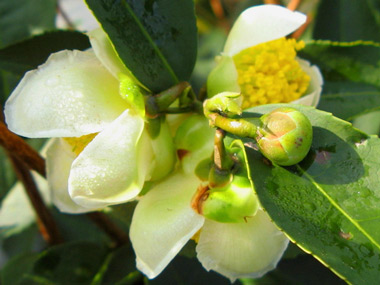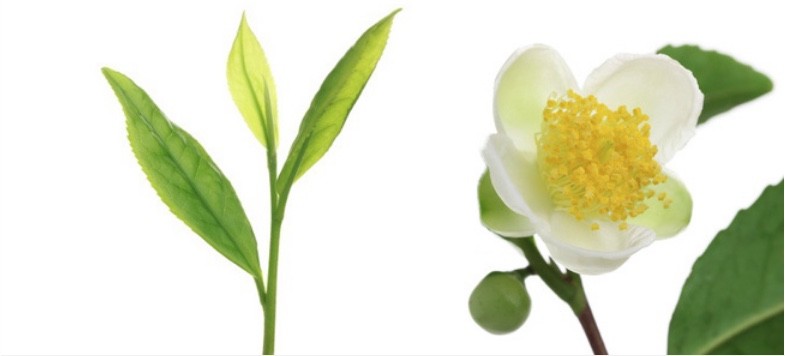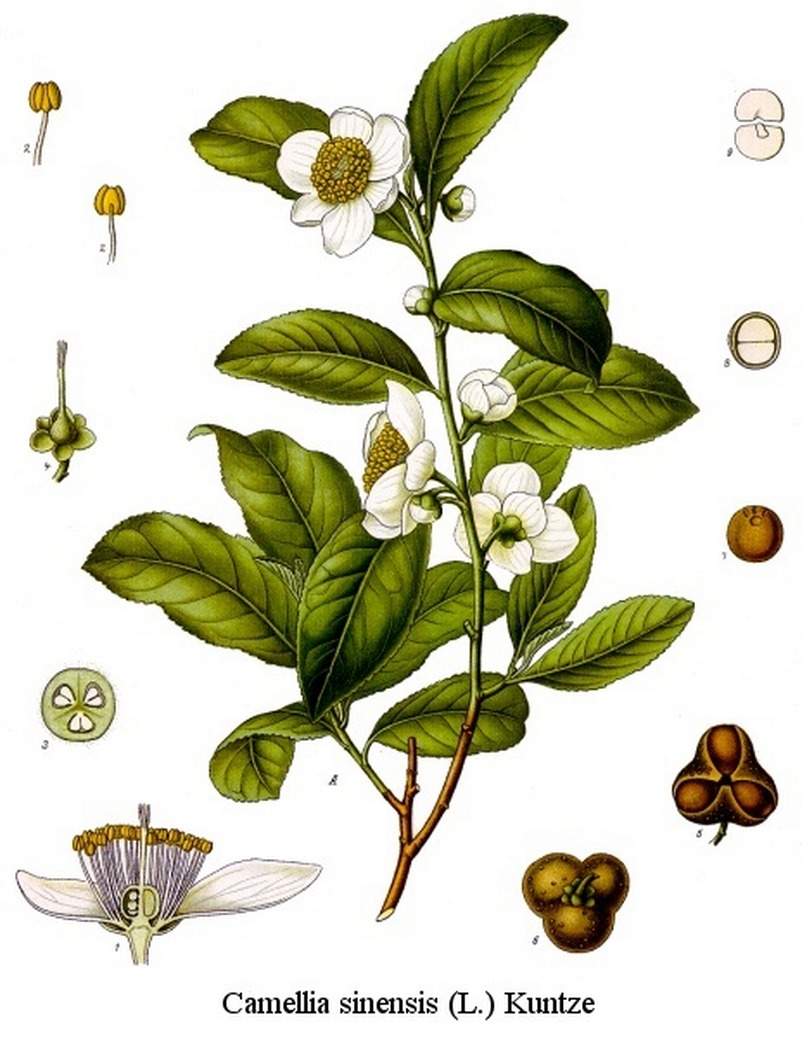The Tea Plant: Camellia Sinensis (L.) O. Kuntze
Green, white, yellow, Oolong, Pu-erh and black tea all originate from the same plant species: Camellia sinensis (L.) O. Kuntze. This species in turn belongs to the family Theaceae, in the order of Ericales, within the Thea subsection of the genus Camellia.
Besides Camellia sinensis’ use as a tea plant, other similar species have different purposes – for example, Camellia oleifera is harvested to produce oil and various other Camellias are grown ornamentally (Camellia japonica). Most domesticated varieties and cultivars of the Theaceae family belong to Camellia sinensis (L.) O. Kuntze.
Camellia sinensis (Thea sinensis)
This beautiful illustration by the renowned botanical artist Koehler (1887) shows a flowering branch of the tea plant: 1) flower in longitudinal section, enlarged; 2) stamens; 3) carpels in cross section; 4) pistil with calyx; 5) and 6) ripe fruit from different sides, with seeds, real scale; 7) seed with binding spines of withered seed buds; 8) dissected seed and 9) seed plant embryo.
Thea Sinensis – Camellia Sinensis
 Camellia sinensis was given its original scientific name – Thea sinensis – in 1753 by the Swedish doctor and botanist Carl Linnaeus (later ennobled Carl von Linné). After the publication of his first work, Linné soon realised that the tea plant was a Camellia species, so renamed it Camellia sinensis. The word Camellia comes from the Latin translation of the surname of the Czech Jesuit Georg Kamel (1661-1706) to honour his contribution to the field botany. In the 19th century, the whole species was finally classified into the genus Camellia by the Scottish botanist Sir George Watt on the basis of its origin, leaf and plant size. Sinensis is the Latin translation for “from China“.
Camellia sinensis was given its original scientific name – Thea sinensis – in 1753 by the Swedish doctor and botanist Carl Linnaeus (later ennobled Carl von Linné). After the publication of his first work, Linné soon realised that the tea plant was a Camellia species, so renamed it Camellia sinensis. The word Camellia comes from the Latin translation of the surname of the Czech Jesuit Georg Kamel (1661-1706) to honour his contribution to the field botany. In the 19th century, the whole species was finally classified into the genus Camellia by the Scottish botanist Sir George Watt on the basis of its origin, leaf and plant size. Sinensis is the Latin translation for “from China“.
The tea plant belongs to the evergreen category. It grows as a tree, half-tree or shrub, depending on its surroundings. When young, the leaves are light green with silky hairs, before becoming dark green, smooth and leathery. The plant has white to pink blossom that has a slight jasmine-like fragrance and look similar to cherry blossom.
The tea flowers are monoecious (male and female) with lightly-scented petals of 2-5 cm in diameter and are normally white. The fruits are green, thick-walled and usually divided into three parts. At first, they appear glossy, before becoming duller and rougher. Tea seeds are brown, thin-walled, semi-circular to round and measure between 1-2 cm long.
Varieties of Camellia Sinensis
Camellia sinensis is divided botanically into three and sometimes four varieties. Besides the variety sinensis, there is also Camellia assamica, dehungensis and pubilimba. When it comes to high-quality teas, the last two varieties play a very minor role and are only cultivated and used in certain regions of China (Southeast). In addition to this, numerous hybrids exist today, in particular crosses of the varieties sinensis and assam, in order to capture the advantages of both plants simultaneously.
Camellia Sinensis: Assamica Variety (Assam Plant)
The assamica variety – often referred to as Camellia assamica – was found in 1823 growing wild in the Assam jungle (India) by Scottish Major Robert Bruce. This discovery came as a sensation; previously the plant was believed to be native to China only. It was the British botanist J. R. Sealy who distinguished the sinensis and assamic varieties of Camellia sinensis (L.) O. Kuntze in 1958.
The leaves of the assamica variety are usually 10-12 cm (although they can grow up to 20 cm) and are light green and glossy. It is an upright growing tree, which on average grows to 8-12 m (sometimes up to 20 m). As a tropical plant, it needs a lot of warmth, humidity and rain.
Assamica is mainly used for the production of black tea and has a significantly higher tannin content than the sinensis variety. Plus, it has much larger, wider leaves and is far more productive than sinensis in terms of yield when cultivated. This fact was quickly observed by the British colonisers ruling India at that time and thus, through many cross-cultivations, the Assam hybrid has today become the basis of most teas worldwide.
Full fermentation produces black tea from harvested (green) tea leaves. This process significantly reduces the strong bitterness of the leaves, which is due to the high tannin content in assamica. A high yield and mild taste are thus achieved through the cultivation and fermentation of assamica black tea. It is therefore not surprising that this tea variety has been widely distributed and commercialised worldwide, in contrast to the traditional domestic consumption of tea in Chinese and Japanese cultures, which still mainly consume green tea. Assamica black tea is therefore mainly an export product, sold on international markets.
Camellia Sinensis: Sinensis Variety (Chinese Plant)
It is the sinensis variety of Camellia Sinensis that is used in green tea, not assamica. This is because fermentation is prevented in the production of green tea varieties, therefore tannin-rich assamica leaves would taste too rough and bitter. As well as its milder, smoother flavour in green tea, the sinensis variety has many more healthy, valuable active ingredients than its Indian counterpart.
While sinensis is mainly used for the highest quality green tea, it is also used for white, yellow, Oolong and even certain black teas. It has a finer aroma and is better suited to high altitudes (in Japan up to about 900 m, in other parts of Asia up to about 2000 m). This makes sinensis much hardier yet slower-growing and less productive than assamica. Nonetheless, this slower growth results in a better quality of tea. For further details on green tea agriculture in Japan, click here.
Sinensis leaves are relatively fine, narrow, hard and dark green with a matt surface. They measure between 5-8 cm long and the plant usually grows 1-6 m tall (uncut).
Green Tea Cultivars and their Specific Health Benefits
About 500 distinct cultivars of the sinensis variety of Camellia sinensis have been bred worldwide so far. Each of these have different flavours and ingredients. Depending on the cultivar, various amounts of amino acids, fatty acids, polysaccharides, catechins, saponins and many more ingredients are produced. These influence the specific health benefits of the tea and, in turn, the particular ailments that it can soothe. Some ingredients – such as anthocyanins and methylated catechins, crucial for fighting certain diseases – are only found in very special cultivars. Likewise, the ratio of certain catechins in specific cultivars explains their particular health effects. Knowledge about the composition of ingredients in the main tea cultivars is therefore of central importance to using green tea for health maintenance and against diseases.
TIP: different green tea cultivars are suitable for different medical conditions; however, exploring the full range of cultivars is also recommended for tea lovers who wish to experience a variety of green tea flavours. For more information about the main green tea cultivars, click >>here<<.
Sources:
- Chen, Zong-Mao; Chen, Liang: “Delicious and Healthy Tea: An Overview”, in: Chen, Liang; Apostolides, Zeno; Chen, Zong-Mao: “Global Tea Breeding”, Springer, 2012, S. 1-11.

